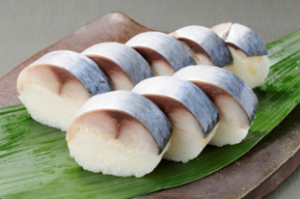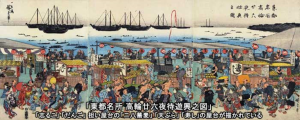Sabakaido (mackerel road) Country of Rice, Japan III Kyosushi and Edomae sushi
Yoshie Doi

Sabasushi (Mackerel sushi) |

Hakozushi |

Maki sushi |

Stone monument at the Sabakaido entrance of Demachi Bridge |
Sushi has its roots in a preserved food that was cooked in the mountainous regions of Southeast Asia, where fish and other animal proteins were marinated with rice and fermented with lactic acid to prevent spoilage. This preservation method was introduced to Japan during the Jomon period and became “Nare-zushi”, which is mainly made by fermenting fish with salt and rice using lactic acid, and Funazushi from Shiga Prefecture is famous.
Later, “Namanare”, which was eaten before it was completely fermented, was born, and during the Genroku period of the Edo period, “Hayazushi”, which was barely fermented, was born, and during the Bunsei era, “Nigiri sushi” was born. did. This is Edomae sushi.
Salt production is popular in western Japan, and salt-cured mackerel has been excavated from wooden tablets at the ruins of Heijo-kyo capital, known as “old mackerel” (furusaba).
From the Edo period to the Meiji period, the original sushi in Kyoto was “mackerel sushi”, and in Osaka, “hakozushi” was the original sushi. With the development of postwar refrigeration technology, Edomae nigiri sushi became widespread throughout the country, and sushi other than Edomae was considered country sushi or home-made sushi.
Norio Kitamura, the head of Kyo Sushi Izuju https://gion-izuju.com/, says, “The basics of Kyo Sushi are boxes, maki, and mackerel. Particularly in the late 18th century during the Edo period, large quantities of mackerel were landed in Wakasa, and when they were turned into salt on the beach and carried day and night by people on their backs instead of relying on oxen and horses,
After about 24 hours, mackerel that has just been salted will become more flavorful and delicious. It seems that there were times when the 40 to 60 kilograms of cargo had to be exchanged at Kutsuki, but they would walk all night to reach Kyoto.
Mackerel stick sushi is sushi made using mackerel that has just been coated with salt and is ready to eat when they arrive in Kyoto. With the opening of the mackerel road, mackerel sushi became more and more popular, and people in Kyoto started eating it on special occasions. In the past, on festival days, my mother would always make a lot of mackerel sushi and share it with the neighbors. It is said that autumn mackerel is the most delicious because of its fat content
In Kyoto City, which is far from the sea, a culture of eating mackerel and conger conger in creative ways developed, and mackerel sushi and conger conger sushi became established. I think this is the result of the dedication of Kyoto’s chefs.
In other prefectures, the conger conger was added to the soup stock and discarded, but in Kyoto, the conger conger bone was made easier to eat, and the genre of conger conger cuisine was expanded. It is said that the bones of a conger conger are cut into 25 bones per inch (approximately 3 cm). This is a craftsmanship technique that cuts only the meat and bones, leaving a single layer of skin, and has been passed down since the Edo period, and chefs in Kyoto cherish this knife.
There is a special way to cut fish that tests the chef’s skill, and it is said to be growing up a skillful chef for the first time, and we have been trying to figure out how to make it easier to preserve fish that are easily perishable.

Common Edomae sushi refers to fish caught in Tokyo Bay as a topping. Kyoto sushi was marinated in vinegar or steamed, and never used raw fish.
“Edomae sushi” originally referred to sushi made with fish caught in Tokyo Bay (Edo Bay) before the Edo period. In the early Edo period, meals were simple, consisting of one soup and one dish, and people ate at home, but the Great Meireki Fire (1657) burned down two-thirds of Edo City. Edo Goverment gathered carpenters, plasterers, and falconers from all over the country.
The number of craftspeople working at delicatessen shops will increase to cater to people who come to Tokyo from rural areas and work alone. The vacant lot in the fire shelter became a hangout spot for single employees and became a popular area with food stalls.
Around the Genroku period, charcoal became popular, and grilled fish, soba, and oden that could be cooked on the spot began to be sold.Soon, the number of people doing business at food stalls increased, and Nara chahan was sold at teahouses in the precincts of Sensoji Temple in Asakusa. It is said that this is the origin of the food shop.
Later, soba restaurants opened in 1664 (Kanbun 3), and sushi, tempura, and eel became popular as fast foods during the Kyoho era. This is a representative of a carrying stall.
The format of the stalls was furi-uri (stick-hand-fururi), which sold ingredients, vegetables, fish, Nanban sweets, koji, oil, bonito, goldfish, and seedlings, and the shogunate approved 49 types of food stalls. Carrying food stalls are typified by soba restaurants that are carried around. There are also food stalls called tokomise in the temple grounds or in front of the temple gates. The food stalls at Yataimise are stationary, temporary stores that serve sushi, and are not portable stores.
Nigiri sushi was sold during the Bunka Bunsei era (1804-1830) as vinegared rice topped with fish and other toppings, and the vinegared rice was the size of a rice ball and sold for 4 or 8 mon each. (1 sentence is approximately 32.5 yen) The basis of Edomae cuisine is dark soy sauce, which is different from the light soy sauce of Kyoto. Dark soy sauce is the basis for soba soup and tempura tempura.
Edomae sushi has evolved over time, and Edomae sushi and Kyoto sushi have evolved into sushi that takes advantage of the characteristics of each region.
The end of document
Translated by Masami Otani
